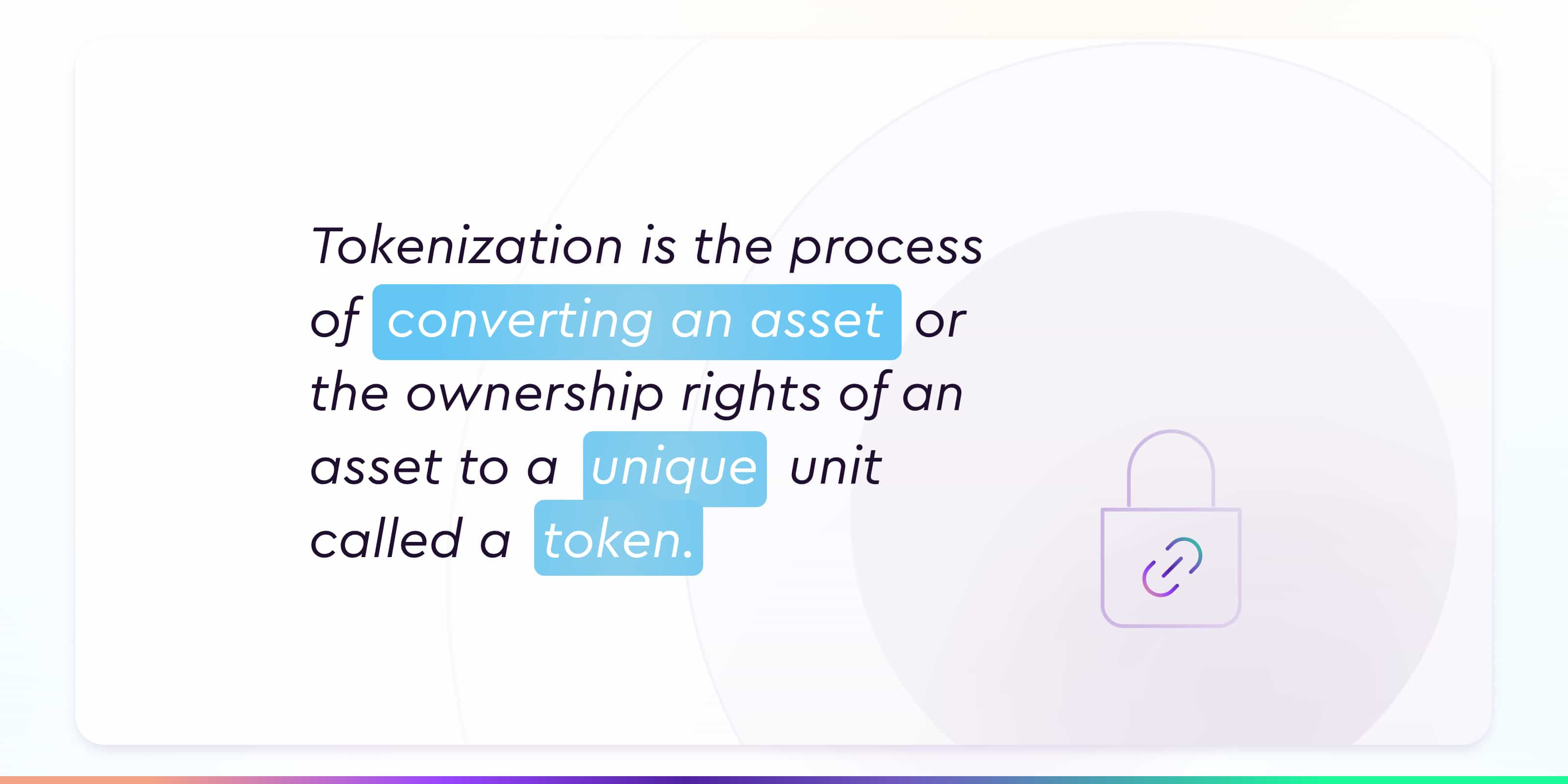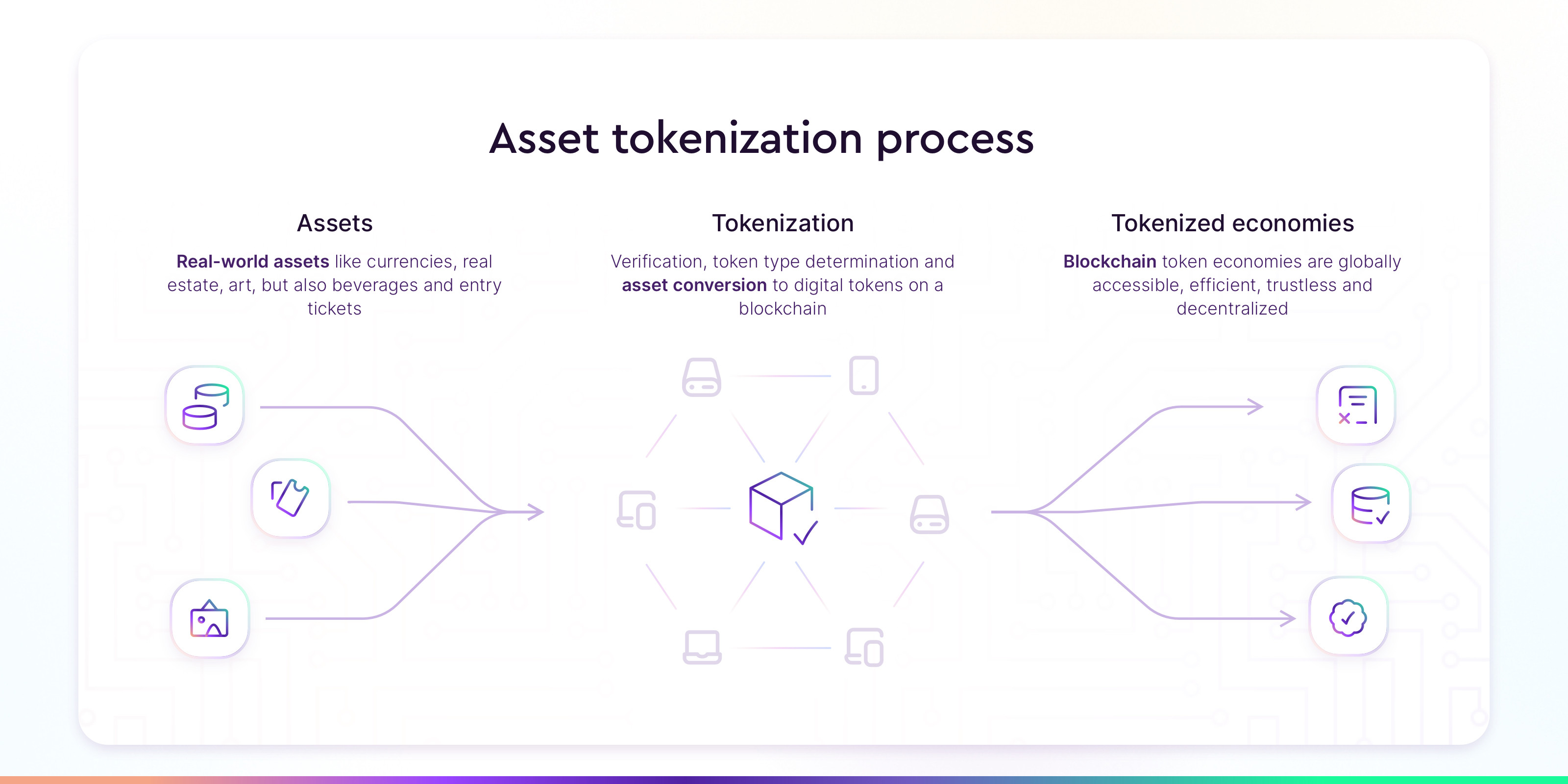Asset tokenization with blockchain technology breathes new life into an existing concept and gives it stronger foundations, increasing its potential.
Table of contents
What is tokenization?
Tokenization is the process of converting an asset or the ownership rights of an asset to a unique unit called a token.
Tokenization of data
Tokenization of data entails that sensitive information is replaced with unique, non-sensitive tokens. These tokens have no inherent value or meaning, making them useless to anyone who gains access to them without proper authorization. It ensures that the original data remains secure while allowing for seamless data processing and storage.

Tokenization of assets
Now that we have a clear understanding of tokenization let's shift our focus to the tokenization of assets. In essence, asset tokenization involves representing ownership rights or the assets themselves as digital tokens on a blockchain.
These assets can be tangible, such as:
✅Real estate✅Art✅Commodities
Or intangible, like:
✅Voting rights✅Ownership shares in a company✅Content licensing
The idea behind asset tokenization is to make assets more accessible, divisible, and transferable for everybody.
Differences between data and asset tokenization
The fundamental concept of tokenization is similar, but the focus and application differ significantly. Tokenization of data is about securing information, while tokenization of assets is about transforming physical or digital assets into digital tokens to enable new forms of ownership and trading.
Types of traditional tokenization
Traditional tokenization methods have been in use for protecting payment information and sensitive data. Here are some key categories within traditional tokenization:
✅Vault tokenization✅Vaultless tokenization✅Natural language processing tokenization
Vault tokenization
Vault tokenization is a widely used method for protecting payment information. It involves creating tokens that can be used to process payments without exposing card numbers or other sensitive data.
Vaultless tokenization
Vaultless tokenization is an innovative approach that doesn't require a token vault for storage. Instead, it relies on cryptographic devices and algorithms to convert data into tokens securely.
Natural language processing tokenization
This type of tokenization breaks down complex information into simpler terms, making it more understandable for computers. It includes word, sub-word, and character tokenization and is often used in various data-processing applications.
“Tokenization adoption was poised for success six years ago, but progress was limited. Renewed interest might feel like déjà vu, but stronger business fundamentals and structural changes suggest the path could be different this time” - McKinsey, 2023
How tokenization is changing
From physical to digital
Traditionally, participants in a tokenized system will most likely possess a physical asset. It means that the earned tokens need to be stored physically. Many disadvantages can be observed, many of which most people have experienced themselves.
For example, the participant can lose earned tokens, and the issuer of the tokens won’t have the possibility to track and therefore protect the participant from inconvenient events like these. Physical tokens come with more disadvantages. To mention a few: they are sensitive to fraudulent behavior, are inefficient in usage, and cost money to produce.
From digital to blockchain
Using the concept of tokenization with a blockchain-based system functions without the need for intermediaries and third parties. Tokenization using blockchain technology offers a solution to close the gap between global and virtual worlds, ensuring both worlds benefit from each other.
While the concept of asset tokenization isn't entirely new, blockchain technology addresses several critical flaws in traditional asset tokenization platforms. These flaws include issues related to liquidity, accessibility, and transparency.

Why there is a need for blockchain
Traditional asset tokenization platforms often face challenges in terms of liquidity. It can be challenging to find buyers or sellers for fractional ownership of assets. Additionally, the process of buying and selling these assets can be time-consuming and involve intermediaries.
Blockchain technology offers a solution to these issues. It enables a much more accessible experience for fractional ownership of assets, making it easier for individuals to invest in high-value assets. Moreover, blockchain's transparency ensures that the ownership of assets is clear, reducing the risk of fraud and disputes.
Types of blockchain tokenization
In the realm of blockchain, we encounter various types of tokenization that offer unique advantages and use cases. Here are the main types of blockchain tokenization:
✅Governance tokenization✅Utility tokenization✅Fungible tokenization✅Non-fungible tokenization
Governance tokenization
Governance tokens represent voting rights and are used to participate in decision-making processes within a blockchain system.
Utility tokenization
Utility tokens grant access to specific products or services on a blockchain network. They can be used for actions such as paying transaction fees, participating in a decentralized market system and much more.
Fungible tokenization
Fungible tokens are standardized blockchain tokens with identical values. They can be easily exchanged for one another, similar to traditional currencies like the U.S. dollar.
Non-fungible tokenization
Non-fungible tokens (NFTs) represent unique assets with distinct characteristics. They are often used to represent digital art, collectibles, and other items where individual traceability is crucial.
Learn more about the benefits of NFT token-gating.
How does the asset tokenization process work?
So, how does blockchain enable asset tokenization? At its core, blockchain is a decentralized ledger that records transactions in a secure and transparent manner. When an asset is tokenized, each token's ownership is recorded on this distributed ledger. This ensures that ownership is indisputable, and the transaction history is immutable.

The decentralized nature of blockchain means that there is no central authority governing these transactions, which enhances security and trust in the system. This enhanced trust enables a paradigm shift, in which token-gated communities are poised to become the future of brand loyalty. Once an asset is tokenized on a blockchain, it can be easily traded, transferred, and divided among multiple owners. It’s an important reason why this technology is ideally suitable for blockchain loyalty programs.
Tokenized economies
As the adoption of blockchain technology continues to grow, the concept of tokenization has extended beyond individual assets. It has given rise to tokenized economies, where a wide range of assets and services are represented as tokens on blockchain networks. Token economies refer to the economics of ‘tokenized’ goods and services. In these tokenized economies, tokens serve as a means of exchange, a representation of value, and a tool for facilitating various transactions. Within our own ecosystem, we leverage the concept of tokenized economies through our blockchain loyalty rewards.
Examples of tokenized economies
This might sound complex. The concept of a token economy, however, is nothing new. Examples of where token economies can be used are:
✅Big festivals✅Gym memberships✅Concerts✅Bars/restaurants✅Regular discounts
.
 Through web3 loyalty programs that leverage tokenization, brands are empowering their communities to engage and get rewarded for it.
Through web3 loyalty programs that leverage tokenization, brands are empowering their communities to engage and get rewarded for it.
Most suitable blockchain
Now that we've explored the various aspects of asset tokenization, it's time to consider which blockchain platform is best suited for this revolutionary process. One blockchain platform that stands out in this regard is Solana. We found out a long time ago that Solana is our perfect partner.
These are Solana’s key components that make them the ideal blockchain:
✅Performance✅Cost-efficiency✅Scalability✅Availability

Performance
Solana is renowned for its lightning-fast transaction processing capabilities. With its high throughput and low latency, it can handle thousands of transactions per second, making it ideal for applications that demand near-instantaneous confirmation. Within the announcement for Visa’s Solana and USDC pilot, which they recently announced, Visa described Solana’s speed for transactions and finality to be two driving factors as well.
Cost-efficiency
Solana’s efficient consensus mechanism and low transaction fees make it an economical choice for asset tokenization. This affordability is particularly advantageous for smaller investors and businesses looking to tokenize assets without incurring excessive expenses.
Scalability
Moreover, Solana's scalability is a key advantage. As more assets are tokenized and the demand for blockchain-based solutions grows, scalability becomes paramount. Solana's architecture allows it to seamlessly scale with increased network activity, ensuring that it can accommodate the growing ecosystem of tokenized assets without compromising performance.
Availability
Solana stands out as a blockchain for its robustness and availability. Unlike some other blockchain networks that may experience bottlenecks or scalability issues during high-demand periods, Solana has demonstrated its capacity to handle a vast number of transactions concurrently, ensuring uninterrupted functionality even during peak usage.
Shopify, a leading e-commerce platform, has also recognized the advantages of Solana. Its recent integration with Solana showcases the blockchain's potential to revolutionize the world of e-commerce through tokenized loyalty programs and asset-backed tokens. Read more about Shopify and Solana Pay.
How you can start
If you're ready to embrace tokenized loyalty and rewards programs for your brand and community, look no further than Crowny. Get started by exploring Crowny's user-friendly solutions and expert guidance. Let us help you unlock the power of tokenized economies and elevate your brand's customer loyalty.
Join Crowny today, sign up for early access.

